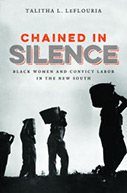Chained in Silence: Black Women and Convict Labor in the New South

Author: Talitha L. LeFlouria
Publisher: Chapel Hill: The University of North Carolina Press, 2015. 257p.
Reviewer: William S. Kiser | March 2016
Inspired by a desire to uncover the realities of her grandmother’s post-Civil War Southern world, Talitha LeFlouria offers a detailed glimpse into a heretofore underexplored regime of African American women’s convict labor that proliferated after the Thirteenth Amendment banned slavery in its most obvious form. Focusing on post-emancipation Georgia, LeFlouria offers an alternative to Douglas Blackmon’s concept of neo-slavery by arguing that convict leasing was not simply “a return to slavery” in a strict sense of the term (8). Instead, she sees prisoner labor, along with other systems of freedom-limiting servitude like debt peonage and sharecropping, as a bridge between the Old and New South, a formative aspect of long-term social and cultural change.
In five chapters, LeFlouria’s deep research and creative interpretations breathe life into the previously muted voices of subaltern convict women laborers. As the author points out, African American women have, until now, been the missing element in previous studies of the South’s convict leasing system. In Georgia, that regime lasted from 1868 to 1908, during which time approximately 2,000 black male and female convicts were leased each year to industrial operations in coal mining, iron manufacturing, and brickmaking.
Chapter one analyzes “Negro criminality” and the role of race in accusation, conviction, and sentencing for alleged offenses (23). Through numerous captivating but heartrending vignettes, LeFlouria illustrates how racialized, gendered, and sexual violence worked in tandem with the carceral state to provide white Southerners with mechanisms for social control after the Civil War. The second chapter examines the types of work performed and the tortuous daily routines of black women felons, arguing that their forced industrial labor was instrumental “in the construction of New South modernity” (62). A third chapter focuses on female prison camps like Smithsonia, Old Town Plantation, and Camp Heardmont, analyzing deplorable living conditions, physically and sexually abusive treatment, and methods of everyday resistance. The subsequent chapter moves on to the Georgia State Prison Farm, offering detailed analyses of individual black female convicts and noting ominously that, “wherever incarcerated women lived and labored, sickness and death were sure to follow” (168). In 1908, Georgia eliminated its convict leasing program and replaced it with an even more repressive chain gang system, which LeFlouria describes in the final chapter.
The author argues persuasively for the importance of gender in convict labor studies, and she skillfully places the service of black female prisoners within the broader contexts of white social control and postbellum Southern industrialization. Through a dualistic approach in which she emphasizes both the role of women as well as the historical importance of an under-analyzed form of coercive servitude, LeFlouria has offered a refreshing new direction for scholarly discourse on free and unfree labor in nineteenth century America. Should scholars heed her call, this direction might be expanded even further by linking the experiences of coerced labor and sexual exploitation that black women convicts endured in the South, with the experiences of female Indian captives and debt peons in the American West, providing a means whereby we might better understand women’s enslavement and servitude in continental terms.
William S. Kiser, Arizona State University


